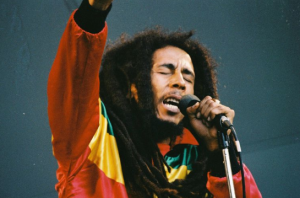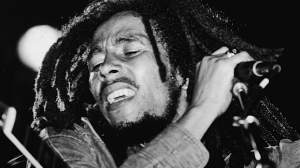 Last night marked 35 years since Bob Marley & The Wailers played their final show in Oakland. Touring in support of 1979’s Survival, widely regarded as Marley’s most politically militant album, the band performed a scintillating two hour set at the Oakland Auditorium, i.e. the currently defunct Kaiser Convention Center, across the street from Laney College on the southwest side of Lake Merritt. While it wasn’t Marley’s first time doing a concert in The Town (he’d played The Paramount on several occasions in 1975 and ’76), it was almost certainly his most significant.
Last night marked 35 years since Bob Marley & The Wailers played their final show in Oakland. Touring in support of 1979’s Survival, widely regarded as Marley’s most politically militant album, the band performed a scintillating two hour set at the Oakland Auditorium, i.e. the currently defunct Kaiser Convention Center, across the street from Laney College on the southwest side of Lake Merritt. While it wasn’t Marley’s first time doing a concert in The Town (he’d played The Paramount on several occasions in 1975 and ’76), it was almost certainly his most significant.
For starters, the show’s location was no accident. As has been widely discussed in articles and documentaries, this tour witnessed Marley deliberately seeking out concert halls that would prove inviting to the black community, with whom he’d famously struggled to find a foothold in the U.S., despite widespread international popularity. While in future years pop music fans would more quickly identify the Oakland Auditorium as the site of The Grateful Dead’s annual New Year’s Eve shows, in 1979 it was likely better known as the place James Brown and Marvin Gaye, among many other black American music luminaries, played when they passed through The Bay. And though Marley’s impetus to perform at sites favored by the black community is best remembered and most dramatically symbolized by his decision to forego a performance at Madison Square Garden in New York’s midtown Manhattan neighborhood a month earlier, opting instead to play four consecutive nights at The Apollo in Harlem, the Oakland Auditorium choice was equally intentional. As one concert attendee states in an online forum about the show, “He could easily have filled the Coliseum or the Stick, but chose to do more accessible venues.”
The concert’s similarly notable for some of the unusual sonic avenues the band explored that night. Specifically, The Wailers experimented more dramatically with dub effects (reverb, echo, etc) on Marley’s voice and several instruments than in any of the shows from that year’s slate. Coupled with the Zap Pow horn section that joined them for the Survival tour (the only time The Wailers included brass players in their stage performance, which makes sense given the prevalence of sax, trumpet, and trombone on the album), the concert’s sound proved considerably more expansive than that of the usual Marley live experience.
Another largely unknown aspect of the Oakland gig is the guest appearance of Rolling Stones guitarist Ron Wood during the six-song encore. As Wood explains in his autobiography, Wailers guitarist Al Anderson had his gear lost on the way up from L.A., where the band had just played a benefit for boxer Sugar Ray Robinson’s Youth Foundation. He phoned up Wood to borrow a guitar, whereupon the Stones’ axe man flew into town and swung by for the save a mere few hours before show time. He was reintroduced to Marley backstage (they’d met once prior in Mandeville, Jamaica), and after sharing a few spliffs and jamming to some of the night’s planned songs, it was agreed that Wood would join the band for their last few numbers. Given Oakland’s standing as a nexus of musical multiplicity, it somehow makes perfect sense that this should be the city in which a chance collaboration of distinguished figures at the top of differing popular genres would transpire.
I first heard a few tracks from this show about a decade ago, on KPFA’s long-running Reggae Express. Host Spliff Skankin would traditionally begin the two-hour Tuesday night program with an excerpt from one of Marley’s many live gigs, often a bootlegged audience recording. Already a fairly seasoned roots reggae head, I was nonetheless unaware that The Wailers had ever played in Oakland. When the site of that evening’s selection was revealed in a brief speaking break about a half-hour into my listening sesh, I was floored to hear that the concert had taken place all of ten minutes from the studio apartment at which I was then blaring it.
On that week’s walks to and from Lake Merritt BART—which, at the time, entailed a shortcut through the former Oakland Auditorium’s parking lot—I would imagine hearing the sound of Marley’s voice, accompanied by the foundation rhythm of the Barrett brothers on drums and bass, along with the hypnotic instrumentation provided by the rest of the band and the I-Three’s majestic vocal harmonies, billowing out over the lake. I’d wonder how far the concert could be heard (might the resonance of the guest horns section ripple all the way up to Grand Avenue? Would folks downtown be able to make out the recurring skank guitar riff?), then brainstorm ways I could get my hands on a recording of the show in its entirety. To my delight, I’d find out that black and white video of the gig was captured by Bill Graham Presents, the event’s promoters, and that soundboard-quality audio of it had been circulating in the tape-traders scene for years. Score!
In the decade or so since first stumbling upon this momentous episode in Marley’s touring history, I’ve thought further about the fittingness of the show’s location, particularly in the context of Oakland’s preeminent radical political entity, the Black Panther Party for Self Defense. Though the Panthers eschewed religion for a bold, brash, racial and economic justice politic that included social uplift programs and armed self-defense and Rastafarians mostly avoided overt involvement in political organizing, instead expressing their Afrocentric, anti-establishment worldview through spiritual doctrine and a largely back [read: forward]-to-nature lifestyle, these groups can nevertheless be viewed as corresponding branches of the black liberation movement in the Americas during the latter half of the 20th century.
As such, there’s something especially striking about Marley, Rastafari’s most avowed ambassador, playing his most politicized body of work (initially entitled Black Survival, mind you, before the execs at Island Records put the kibosh on that!) in a space so connected to the history of the Panthers’ movement. After all, the Oakland Auditorium was the site of a massive birthday rally to support Panther co-founder Huey P. Newton, when he was facing trumped-up charges for killing an Oakland cop, just over a decade prior to Marley playing the venue. In addition, the Auditorium’s located smack between two seminal sites of Panther lore—the Alameda County Courthouse, where numerous trials and protests pertaining to Party members took place, and the high-rise building at 1200 Lakeshore, site of Newton’s infamous penthouse apartment, from where he regularly observed Panther-involved demonstrations on the courthouse’s front steps via telescope, while FBI agents occupied an apartment across the hall and wiretapped his phone. In light of the Panthers’ indelible imprint on Oakland’s collective psyche, Marley’s set at a Town landmark bookended by Party-affiliated settings holds particular political and poetic import.
Consider the armed police attacks on Panther members at the time, and the gun battles that ensued, then think about hearing Marley sing I Shot The Sherriff in the city where so many of those clashes took place. Reflect for a second on the Panthers’ lauded Free Breakfast Program (which, unbeknownst to many, predates the federal government’s implementation of a similar, if much better funded, program in U.S. public schools), then imagine hearing Them Belly Full (But We Hungry) in the city where said program was spawned. How many active or ex-Panthers were in the crowd that night? How many future Bay Area political activists were present and were perhaps galvanized towards social justice work through the messages they heard from reggae music’s royalty on that celebrated stage?
Of course, by 1979, Oakland’s black radical trajectory, best evidenced by the Panthers, had largely fallen victim to a reformist agenda. Lionel Wilson, the city’s first black mayor, had been elected two years prior, and while he did advance an economically progressive platform that championed the rights of women and people of color, he was also criticized from the left as a centrist too friendly to big business interests. Though the Panthers were technically still in existence, they had for all intents and purposes been decimated by COINTELPRO-sown infighting. Reagan’s ascension was around the corner, and with it a decade of conservative politics at the state and national level that, to the uninformed anyway, would make Panther culture seem a dusty relic of a distant past. Marley, too, would be gone a mere year and a half after, victim to untreated toe cancer that spread through the rest of his body. In this sense, his impassioned call for Survival over the course of his final concert in The Bay can be seen not just as homage to African cultural retention in the aftermath of the circum-Atlantic slave trade and the ensuing era/s of anti-black racial oppression, but also as macabre warning of the unforeseen cultural and political struggles to come.
As for the Oakland Auditorium itself, longtime locals no doubt know that it’s been closed for close to a decade. Built in 1914 (yup, exactly a century ago), and renamed for 20th century U.S. industrialist Henry J. Kaiser following a $15 million renovation 70 years later, the Beaux Arts-style building, city-owned and once a center of civic life, has sat vacant since 2006. Officially, its closure came about because it wasn’t profitable, and the city’s budget could no longer support it. Various attempts to sell the building have fallen flat (among them a strange, short-lived venture in which the city actually sold the building to its own redevelopment agency, in hopes that they would have better luck selling or finding some public use for it—until the state dissolved that agency in 2012, sending ownership back to city government!).

Proposals to turn the space into something other than the 6,000 person concert arena, plus theater and ballroom, that still survives in the dark—i.e. a new base for the city’s downtown library, or an international trade center—have similarly sputtered. Accordingly, in January of 2012, citing its prolonged state of stagnancy, Occupy Oakland activists attempted to take over the building and establish a social center of sorts within its walls. They were confronted there by OPD, and about 400 people were arrested over the course of the day. While the action had countless detractors, the attention it focused on the space’s non-operational status certainly reignited some important debate on what this building’s role in Oakland’s future should be. If the city has a clearer vision than that proposed by Occupy a couple years back, or is simply more committed to creating an entertainment venue than a hub of social services or political education, many are still waiting to at least hear that articulated.
Estimates of the renovations now needed to the building, including a wide scale repair of its heating system, have generally landed around $7 million. With the recent completion of the Measure DD-funded greening of East 12th Street and Lakeshore Boulevard, along with nearby Oakland Museum’s redesign and consistent Friday evening programming (“Off The Grid”)—to say nothing of the influx of new money into downtown (excuse me, “Uptown”) Oakland’s nightlife ecosystem—it doesn’t seem a stretch to imagine some experienced investors, concert hall managers, and booking agents resuscitating the legendary venue, a la what we’ve seen over the last five years with The Fox Theater. Given the lengthy list of significant cultural figures who’ve graced the Oakland Auditorium’s stage—beyond Marley and the aforementioned musical acts, Marcus Garvey, Martin Luther King, and the Dalai Lama all spoke there as well—it would be a shame for this historic site to remain little more than a concrete ghost.
As we take a moment to celebrate 100 years since its construction and 35 years since reggae’s most celebrated star shone his light on Oakland’s masses, may those of us committed to honoring The Town’s creative history and supporting its meaningful evolution pause to reflect on how we can individually and collectively contribute to the Oakland Auditorium’s long-awaited rebirth – preferably as the “consolation of the arts” it was always meant to be.




